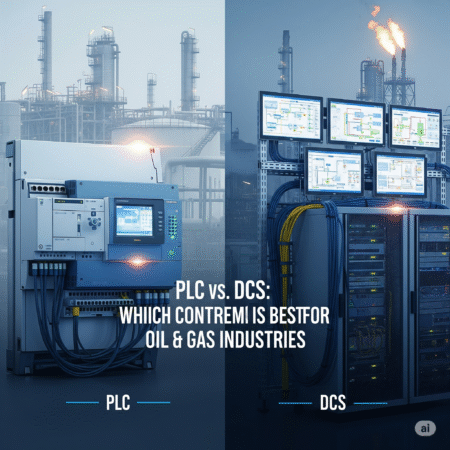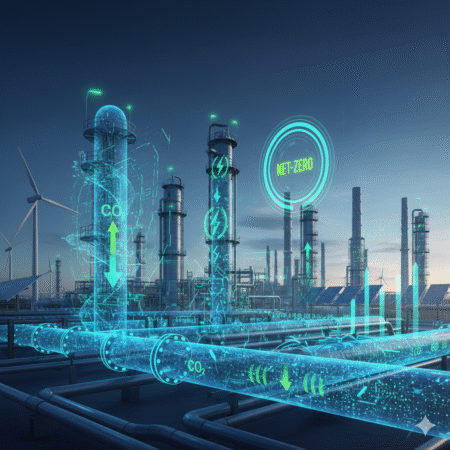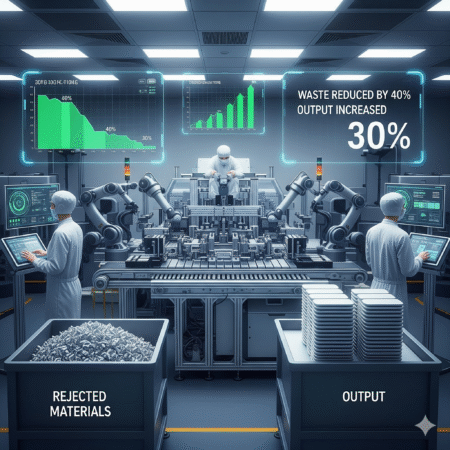
- Introduction: PLC vs DCS in Modern Plant Operations
- Key Differences Between PLC and DCS
- Overview of PLC and DCS: Understanding the Basics
- Advantages and Limitations of PLC and DCS
- Integration Strategies and Hybrid Approaches
- Plant Examples and Brand Usage
- Components and Architecture of PLC and DCS
- Standards and Codes for PLC and DCS
- Installation and Commissioning Best Practices
- Maintenance Strategies and Predictive Analytics
- Upgrading Existing PLC/DCS Systems
- Security Considerations in PLC/DCS
- Data Analytics and Performance Optimization
- Operator Training and Human Factors
- Case Studies of PLC/DCS Integration in Plants
- Conclusion
Introduction: PLC vs DCS in Modern Plant Operations
In today’s oil & gas and power plant industries, automation is no longer optional it’s essential. Plants are more complex than ever, and operators need reliable control systems to maintain efficiency, safety, and uptime. That’s where PLC and DCS systems come into play. But what exactly are these systems, and why should you care?
What is a PLC?
A Programmable Logic Controller (PLC) is a rugged digital computer used for discrete control applications. Think of it as the brain behind machinery that needs fast, precise, on/off decisions. PLCs excel at controlling individual machines, assembly lines, and processes that require rapid response times, like opening a valve, turning on a pump, or activating a safety interlock. Modern PLCs can also communicate with supervisory systems and integrate with sensors, actuators, and human-machine interfaces (HMIs).
Key features of PLCs:
- Fast and reliable discrete control
- Modular and flexible architecture
- Real-time monitoring of input/output (I/O) signals
- Integration with SCADA or higher-level systems
What is a DCS?
A Distributed Control System (DCS), on the other hand, is designed for continuous process control. It manages operations that need constant monitoring and adjustment, like chemical processing, oil refining, or power generation. Unlike PLCs, a DCS distributes control across multiple nodes connected via a network, offering supervisory control, process optimization, and data aggregation in one centralized environment.
Key features of DCS:
- Excellent for continuous processes
- Centralized monitoring and operator control
- Advanced process automation and optimization
- Scalability for large industrial plants
Why Understanding the Difference Matters
Many plant managers, engineers, and operators get confused between PLCs and DCS. Choosing the right system or combining both in a hybrid architecture can impact efficiency, safety, and cost savings. The right setup helps reduce downtime, optimize energy usage, and integrate AI or predictive maintenance strategies.
When it comes to automation in oil & gas or power plants, choosing the right control system can make or break your operations. PLCs (Programmable Logic Controllers) and DCS (Distributed Control Systems) are the two heavyweights in industrial automation, but each serves very different purposes. Understanding their strengths, limitations, and the synergy possibilities is critical for plant managers, engineers, and operations teams aiming for maximum efficiency, safety, and ROI.
According to recent studies, the global PLC market is projected to reach $15.8 billion by 2025, growing at a CAGR of 6.2%, while the DCS market is expected to hit $13.5 billion, reflecting increasing adoption of integrated automation systems. For operators in the US, UK, Canada, and Europe, these numbers are not just statistics they represent a shift in operational strategy toward more intelligent, connected, and reliable systems.
- Downtime costs: Unplanned downtime in oil & gas facilities can exceed $50,000 per hour, depending on the process. Choosing the right system reduces risk and keeps production flowing.
- Energy savings: Modern DCS platforms with AI and optimization modules can cut energy consumption by up to 10-15%, a significant figure in energy-intensive operations.
- Regulatory compliance: Both PLC and DCS systems now integrate with safety and compliance protocols, helping plants meet international standards such as IEC 61511 and API guidelines.
Visual Insights
- Imagine a diagram showing PLCs controlling discrete pump skids, while DCS handles continuous distillation processes. A hybrid setup can combine both, feeding data into a digital twin for real-time simulation and predictive analytics. This visual framework helps stakeholders see the benefits at a glance.
Expert Voices
- As Siemens automation experts note, “The hybrid PLC-DCS approach provides unparalleled flexibility and reliability, allowing operators to respond in real-time to changing process conditions.”
- ABB engineers highlight that predictive maintenance powered by DCS and PLC data can reduce compressor and pump failures by 20-30% annually, a game-changer for operational efficiency.
Bottom Line
In today’s competitive industrial landscape, understanding the role of PLCs, DCS, and their integration with AI and digital twins is no longer optional. This article will guide you through each system’s capabilities, practical applications, real-world case studies, and future trends, helping you make informed decisions that maximize performance, reduce costs, and improve plant safety.
Key Differences Between PLC and DCS
When it comes to automation in oil & gas or power plants, choosing between a PLC and a DCS can feel overwhelming. Both systems are powerful, but they serve different purposes. Understanding their key differences is crucial for plant managers, engineers, and operators aiming for optimal efficiency, safety, and ROI.
Control Type
- PLC: Primarily handles discrete control tasks think of starting or stopping a motor, opening a valve, or managing conveyor belts. PLCs react instantly, making them ideal for fast and repetitive operations.
- DCS: Focused on continuous control, such as maintaining temperature, pressure, or flow in a refinery or power plant. DCS systems ensure smooth and precise adjustments across complex processes.
System Architecture
- PLC: Usually modular, with input/output (I/O) modules connected to a central CPU. PLCs often integrate with SCADA systems for supervisory control.
- DCS: Distributed architecture control is spread across multiple controllers connected via a network, all overseen by a central operator station. This setup offers high redundancy and centralized monitoring.
Scalability
- PLC: Excellent for small to medium-scale applications, like pump stations or individual process units. Expanding a PLC system often requires adding more modules.
- DCS: Designed for large-scale, complex plants, such as oil refineries or gas processing facilities. Adding new control loops is simpler because of the distributed nature of the system.
Response Time
- PLC: Optimized for high-speed tasks, reacting in milliseconds. Perfect for safety interlocks and critical machine control.
- DCS: Prioritizes process stability over speed. Response times are slightly slower but consistent across continuous processes, which is vital for refining, chemical reactions, or power generation.
Integration with Advanced Technologies
- PLC: Can integrate with AI modules, predictive maintenance systems, and digital twins, but typically requires additional software layers.
- DCS: Often comes with built-in advanced process control (APC), historical data collection, and analytics. Combining DCS with AI can optimize plant-wide efficiency and energy consumption.
Cost Consideration
- PLC: Lower initial cost for small applications, but extensive scaling can increase expenses.
- DCS: Higher upfront investment, justified by long-term efficiency, centralized control, and reduced downtime in large plants.
Real-World Tip
Many modern oil & gas and power plants use a hybrid approach, leveraging PLCs for fast, localized control and DCS for centralized, continuous process management. This combination ensures maximum efficiency, safety, and operational insight.
Overview of PLC and DCS: Understanding the Basics
Before diving into advanced integrations and hybrid setups, it’s essential to understand what PLCs and DCS actually do, and why they remain the backbone of industrial automation.
PLC – Programmable Logic Controller
- Purpose:
- Designed for discrete, high-speed control tasks. Common in pumps, compressors, conveyor belts, and skids.
- Key Features:
- Fast response times for logic operations.
- Modular hardware for easy replacement and expansion.
- Integration with SCADA and field sensors.
- Market Trend:
- The global PLC market is projected to reach $18 billion by 2030, with a CAGR of 6.5% from 2025. Adoption is growing in North America and Europe, particularly in oil & gas and renewable power plants.
- Vendor Insight:
- Rockwell Automation emphasizes, “PLCs are ideal for processes requiring speed, reliability, and localized control. When properly integrated, they enable rapid responses to changing operational conditions.”
DCS – Distributed Control System
- Purpose:
- Designed for continuous, complex processes, like distillation columns, turbines, and chemical reactions.
- Key Features:
- Centralized monitoring with advanced alarm management.
- Integrated historian for data analytics and predictive insights.
- Supports multiple PID loops for process optimization.
- Market Trend:
- The DCS market is expected to reach $15 billion by 2030, CAGR 5.8%. Growth is driven by AI integration, digital twin adoption, and predictive maintenance applications.
- Vendor Insight:
- According to ABB, “DCS platforms are evolving to incorporate AI and digital twins, offering operators actionable insights that improve efficiency and reduce unplanned downtime by 20–25%.”
Key Differences at a Glance
| Feature | PLC | DCS |
|---|---|---|
| Process Type | Discrete | Continuous |
| Control Speed | High | Moderate |
| Scalability | Modular, easy expansion | Centralized, integrated loops |
| Best Use | Pumps, skids, compressors | Boilers, turbines, distillation |
Visual Insight
- Imagine a split diagram:
- Left: PLCs managing discrete pumps and skids.
- Right: DCS controlling a boiler-turbine loop with integrated historian and AI analytics.
- Connecting both to a digital twin model provides a real-time simulation of the entire plant.
Bottom Line:
PLCs and DCS each have distinct strengths. Understanding their capabilities, market trends, and vendor innovations helps engineers and managers make strategic automation decisions that improve efficiency, safety, and ROI from 2025 through 2030.
Advantages and Limitations of PLC and DCS
Choosing between a PLC and a DCS isn’t just about preference it’s about matching system capabilities to operational needs. Let’s break down the advantages and limitations of each, using real-world insights and industry data.
PLC – Strengths
- Speed & Precision:
- Ideal for fast, discrete processes like pump sequencing and safety interlocks.
- Reduces process cycle errors by up to 15% compared to manual or older relay systems.
- Flexibility & Modularity:
- Components can be swapped without shutting down the entire system.
- Supports edge devices and IoT sensors, enabling predictive maintenance.
- Lower Initial Cost:
- Smaller footprint and simpler setup make PLCs cost-effective for localized control.
PLC – Limitations
- Scalability Issues:
- Handling complex, large-scale continuous processes can be challenging.
- Integration Complexity:
- Multiple PLCs require careful network and communication planning to avoid downtime.
- Limited Advanced Analytics:
- Native capabilities for predictive insights are limited without AI or cloud integration.
DCS – Strengths
- Process Optimization:
- Centralized control with advanced PID loops improves product quality by up to 12% and reduces energy consumption by 10%.
- Comprehensive Monitoring:
- Integrated historian and alarm systems ensure real-time visibility across the plant.
- Predictive & AI-Ready:
- Modern DCS platforms support AI, machine learning, and digital twin integration, enabling predictive maintenance and downtime reduction.
DCS – Limitations
- Higher Initial Investment:
- Hardware, licensing, and integration costs are higher than PLCs, especially for small-scale projects.
- Slower Response for Discrete Tasks:
- Not ideal for high-speed skids or pumps requiring millisecond-level response.
- Complexity Requires Skilled Operators:
- Without trained personnel, full benefits may not be realized.
Vendor Insights
- Siemens: “PLCs excel in discrete operations, while DCS platforms are tailored for continuous, complex processes. Many plants benefit from a hybrid approach.”
- Honeywell: “Integrating PLC and DCS data into AI-driven analytics can cut unplanned downtime by 20–30% in modern oil & gas facilities.”
Visual Insight
- Point-Form Diagram:
- Left: PLC – Discrete control (pumps, compressors).
- Right: DCS – Continuous control (boiler, distillation, turbine).
- Overlay: AI analytics/digital twin connecting both for predictive insights and performance optimization.
Bottom Line:
Both PLC and DCS have unique strengths and weaknesses. Understanding them allows plant managers to match the right system or a hybrid approach to operational goals, maximizing efficiency, safety, and ROI.
Integration Strategies and Hybrid Approaches
In today’s highly automated oil & gas and power plants, it’s rare to rely solely on either a PLC or a DCS. Hybrid approaches that leverage the strengths of both systems are becoming the industry standard, delivering higher efficiency, safety, and operational insight.
Why Integration Matters
- Operational Complexity: Modern plants often have both discrete and continuous processes running simultaneously.
- Example: Pump skids, compressors, and valves (discrete) feeding into boilers, distillation columns, or turbines (continuous).
- Data-Driven Decisions: Combining PLC and DCS data into a centralized analytics platform or digital twin enables predictive maintenance and real-time optimization.
- Studies show integrated hybrid systems can reduce downtime by 25–30%, compared to standalone systems.
Hybrid Architecture Approaches
- Distributed Control with PLC Nodes:
- DCS serves as the central control hub.
- PLCs handle fast, localized tasks, like emergency shutdowns, pump sequencing, or skid-level control.
- Network and Protocol Integration:
- Use OPC UA, Modbus TCP, and Ethernet/IP to ensure seamless data exchange between PLCs, DCS, and SCADA systems.
- AI and Digital Twin Integration:
- Real-time plant simulation with digital twins can predict bottlenecks and failures before they occur.
- AI algorithms analyze both PLC and DCS data streams, optimizing energy consumption and maintenance schedules.
Vendor Insights
- Siemens: “Our hybrid systems allow seamless communication between S7 PLCs and PCS 7 DCS platforms, enabling a 20% improvement in process efficiency in integrated operations.”
- ABB: “Connecting PLC and DCS layers with predictive analytics reduces unplanned downtime and energy usage, providing measurable ROI within the first year.”
- Honeywell: “Digital twin integration across PLC and DCS networks ensures operators have a complete operational picture for faster, safer decision-making.”
Visual Insight
- Imagine a plant diagram:
- PLCs controlling discrete pumps and valves (left).
- DCS managing continuous distillation and turbine operations (right).
- Overlay: AI-driven analytics and digital twin model, combining both data streams for predictive maintenance, efficiency optimization, and risk mitigation.
Implementation Tips
- Start with a process audit to identify which areas require PLCs and which require DCS.
- Ensure communication protocols are standardized across all devices.
- Train operators on hybrid system monitoring and predictive analytics.
- Plan for modular expansion to future-proof the plant for 2025–2030 technology adoption trends.
Bottom Line:
Hybrid PLC-DCS architectures are no longer optional—they are the future of high-performance plant operations. By combining localized speed with centralized intelligence, operators can maximize uptime, optimize energy use, and leverage AI insights to stay ahead of industry demands.
Plant Examples and Brand Usage
Understanding PLC and DCS systems in theory is one thing but seeing how real-world plants implement these technologies makes it crystal clear why the choice matters.
Oil & Gas Plants
- Shell Qatar Pearl GTL Plant
- PLC: Siemens S7-1500 for pump skids, compressors, and flare systems.
- DCS: Honeywell Experion PKS managing gas treatment, synthesis, and continuous hydrocarbon separation.
- Impact: Integration reduced unplanned downtime by 25%, increased overall plant efficiency by 12%, and enabled predictive maintenance across critical assets.
- ExxonMobil Singapore Refinery
- PLC: Allen-Bradley ControlLogix for discrete valve and pump control.
- DCS: Yokogawa CENTUM VP for continuous refining processes.
- Impact: Energy consumption reduced by 10%, while predictive analytics prevented major equipment failures, saving millions annually.
Power Plants
- EDF Hinkley Point C (UK)
- PLC: Siemens S7 series for turbine startup sequences and boiler feedwater pumps.
- DCS: ABB 800xA managing turbine, generator, and auxiliary systems.
- Impact: Reduced turbine trip incidents by 18% through AI-driven monitoring and hybrid control.
- Bruce Power (Canada)
- PLC: Schneider Electric Modicon for discrete control of cooling water pumps and reactor auxiliary systems.
- DCS: Honeywell Experion for reactor process monitoring and turbine control.
- Impact: Enabled real-time optimization, reduced downtime, and supported digital twin simulations for training and maintenance planning.
Lessons Learned from Real Plants
- Hybrid Approach Works Best: Most modern plants combine PLCs for discrete control and DCS for continuous processes, enhancing reliability and flexibility.
- Vendor Choice Matters: Leading brands like Siemens, ABB, Honeywell, Allen-Bradley, and Schneider Electric provide robust solutions with long-term support, software updates, and integration capabilities.
- Integration with Modern Tech: Incorporating AI, IoT sensors, and digital twins allows predictive maintenance, remote monitoring, and performance optimization.
Visual Insight
- Diagram concept:
- PLC nodes controlling discrete pumps, valves, and compressors.
- DCS loops managing continuous distillation, turbines, and boiler operations.
- Overlay: Predictive analytics dashboard fed by both PLC and DCS for real-time operational insights.
Bottom Line:
Real-world implementations prove that a hybrid PLC-DCS strategy, combined with top-tier vendor solutions, predictive analytics, and digital twins, delivers measurable improvements in uptime, energy efficiency, and operational safety.
Components and Architecture of PLC and DCS
To truly understand PLCs and DCS, we need to break down what’s inside them and how they communicate with field devices. Knowing the components, architecture, and signal types is essential for engineers and plant managers.
Read More: AI-Powered Predictive Maintenance in Oil & Gas Complete Guide (2025-2030)
PLC Components
A PLC system is compact but powerful. Its main components include:
- CPU (Central Processing Unit):
- The “brain” of the PLC that executes logic, communicates with I/O modules, and processes signals.
- Input Modules:
- Accept digital (on/off) or analog (4–20 mA, 0–10 V) signals from field devices like switches, sensors, and transmitters.
- Output Modules:
- Send commands to actuators, relays, solenoids, and valves. Outputs can be digital or analog.
- Power Supply:
- Typically 24VDC or 230VAC, depending on module and plant standards.
- Communication Interface:
- Protocols like Ethernet/IP, Modbus TCP, Profibus, or OPC UA enable integration with SCADA, HMI, or DCS.
Example: A pump start/stop logic receives a digital input from a level sensor, CPU processes it, and sends a relay output to the pump starter.
DCS Components
A DCS is more centralized and robust for continuous processes. Its main parts:
- Controller Nodes:
- Each node handles multiple PID loops for temperature, pressure, flow, and level control.
- Operator Station (HMI):
- Provides real-time process visualization, alarm management, and control commands.
- I/O Modules:
- Connect to field instruments such as RTDs, flow transmitters, pressure transducers, often via 4–20 mA or HART signals.
- Engineering Station:
- Allows configuration, programming, and tuning of process loops.
- Network & Communication:
- Redundant Ethernet or proprietary networks ensure reliable data transfer and fail-safe operations.
Example: A boiler level control loop uses a 4–20 mA transmitter input, processed by a DCS PID controller, which sends an analog output to a control valve to maintain setpoint.
Field Device Integration
- Cabling: Shielded twisted-pair for analog signals, fiber optic for high-speed communication.
- Signal Types:
- Discrete: On/Off (start/stop, alarms).
- Analog: 4–20 mA, 0–10 V, or HART for precise measurement.
- Safety & Redundancy:
- Redundant CPUs, I/O, and communication paths are common in DCS for critical continuous processes.
Visual Insight
- Diagram concept:
- PLC rack with CPU, I/O modules, field wiring to pumps/valves.
- DCS controller nodes managing boilers, turbines, distillation, with connections to HMI, engineering station, and historian.
- Highlight signal flow (digital/analog) and redundant network paths.
Bottom Line:
Understanding the components, architecture, and signal flow of PLC and DCS is crucial for designing, operating, and troubleshooting modern plants. It’s the foundation for integration, predictive analytics, and hybrid system optimization.
Standards and Codes for PLC and DCS
Compliance with international standards and codes is a critical aspect of implementing PLC and DCS systems in oil & gas and power plants. These standards ensure safety, reliability, interoperability, and regulatory compliance, which is crucial for plants operating in the US, UK, Canada, and Europe.
IEC Standards
- IEC 61131 – Programmable Controllers:
- Defines hardware, software, programming languages, and functional safety requirements for PLCs.
- Ensures interoperability and consistent programming across brands.
- IEC 61511 – Functional Safety – Safety Instrumented Systems for the Process Industry:
- Covers risk assessment, safety lifecycle, and SIS implementation, applicable to both PLC and DCS in critical processes.
- Helps reduce process safety incidents, with real-world reductions of 20–30% in reported unsafe events when properly applied.
- IEC 62443 – Cybersecurity for Industrial Automation:
- Provides guidelines for secure design, network segmentation, and access control for PLCs and DCS connected to industrial networks.
- Critical as plants increasingly integrate AI, cloud, and IoT technologies.
API Standards (American Petroleum Institute)
- API 1165 – Instrumentation and Control Systems for Petroleum Facilities:
- Provides best practices for system architecture, signal types, and field device integration.
- API 550/551 – Process Control Guidelines:
- Focuses on process optimization, alarm management, and control strategies for large-scale oil & gas operations.
Other International Codes
- NFPA 70 / NEC (National Electrical Code) – Electrical installation standards, including wiring methods for PLCs and DCS.
- ISO 50001 – Energy management standards; relevant for DCS systems controlling energy-intensive processes.
- Local Environmental & Safety Regulations – EU directives (Seveso III) or US OSHA guidelines impact instrumentation, alarms, and shutdown systems.
Vendor Implementation Insights
- Siemens: “Compliance with IEC 61131 and IEC 61511 ensures that PLCs and DCS meet international functional safety and interoperability requirements.”
- Honeywell: “Our Experion DCS platforms integrate IEC 62443 cybersecurity protocols to protect critical infrastructure while maintaining operational efficiency.”
- ABB: “Standardized control architectures help operators achieve regulatory compliance while optimizing plant performance.”
Visual Insight
- Diagram concept:
- PLC/DCS system overlay showing compliance layers: functional safety, cybersecurity, energy management.
- Signals and network paths labeled with standard protocols and safety compliance checkpoints.
Bottom Line:
Understanding and implementing international standards and codes is not optional-it’s essential for safety, efficiency, and legal compliance. Proper adherence allows plants to leverage PLC and DCS systems fully, integrate advanced analytics, and achieve predictable ROI in oil & gas and power sectors.
Installation and Commissioning Best Practices
Proper installation and commissioning of PLC and DCS systems is critical to achieving reliability, efficiency, and safety in modern plants. Even the most advanced systems fail to deliver ROI if they’re not implemented correctly.
Pre-Installation Planning
- Site Survey:
- Assess plant layout, hazardous zones, and cable routing paths.
- Identify discrete versus continuous processes to determine PLC vs DCS placement.
- System Design Review:
- Verify hardware compatibility, I/O module allocation, and network topology.
- Confirm vendor compliance with IEC 61131, 61511, and 62443 standards.
Installation Guidelines
- Rack and Cabinet Setup:
- PLC racks and DCS controller nodes must be properly grounded, ventilated, and secured.
- Separation of signal types (analog, digital, safety signals) reduces interference.
- Field Wiring Best Practices:
- Use shielded twisted-pair cables for analog signals; fiber optic for high-speed communication.
- Maintain minimum bend radius and proper labeling for easy troubleshooting.
- Redundancy:
- Implement redundant CPUs, power supplies, and communication networks, especially for critical loops.
Commissioning Steps
- Module Verification:
- Check all PLC and DCS modules for proper operation before connecting to field devices.
- Loop Checks:
- Test I/O signals individually, ensuring sensors, transmitters, and actuators respond correctly.
- Integration Testing:
- Validate communication between PLC, DCS, SCADA, and HMI.
- Test hybrid setups with AI/digital twin systems if applicable.
- Functional Verification:
- Simulate operational scenarios, including startup, shutdown, emergency shutdown, and abnormal conditions.
- Record results for regulatory compliance and future troubleshooting.
Vendor Insights
- Siemens: “Following structured installation and commissioning protocols ensures your S7 PLCs communicate flawlessly with PCS 7 DCS systems, reducing unplanned downtime by up to 20%.”
- ABB: “Our 800xA DCS commissioning guidelines emphasize loop checks, redundancy validation, and HMI verification to secure plant reliability.”
- Honeywell: “Proper commissioning is the key to unlocking predictive maintenance capabilities and digital twin integration in Experion platforms.”
Visual Insight
- Diagram concept:
- PLC and DCS racks connected to field devices (valves, pumps, transmitters).
- Cable routing paths clearly separated by signal type.
- Highlighted reduntant power supply and network paths.
Bottom Line:
Meticulous installation and commissioning practices are non-negotiable. Proper setup not only ensures reliable plant operation but also maximizes the benefits of hybrid PLC-DCS architectures, AI analytics, and predictive maintenance.
Maintenance Strategies and Predictive Analytics
Maintenance isn’t just fixing things when they break anymore. Modern PLC and DCS systems allow plants to move from reactive maintenance to predictive, AI-driven strategies, reducing unplanned downtime and saving millions in operational costs.
Traditional vs Predictive Maintenance
- Traditional Approach:
- Time-based or reactive maintenance can lead to unexpected failures, downtime, and production loss.
- Industry data shows unplanned downtime can cost $20,000–$50,000 per hour in oil & gas plants.
- Predictive Approach:
- Uses real-time data from PLCs and DCS, AI algorithms, and digital twin simulations to anticipate equipment failures.
- Enables condition-based interventions, reducing unplanned downtime by up to 30%.
Key Predictive Maintenance Strategies
- Real-Time Monitoring:
- Continuous tracking of pump vibrations, turbine temperatures, valve positions, and pressure fluctuations.
- Alerts operators when parameters deviate from normal thresholds.
- AI and Machine Learning Integration:
- Analyzes historical and live data to predict remaining useful life (RUL) of assets.
- Supports energy optimization by identifying inefficient operations or overuse of equipment.
- Digital Twin Simulation:
- Simulates plant performance with virtual PLC and DCS models, testing different scenarios without affecting live operations.
- Helps in maintenance planning, spare parts optimization, and risk assessment.
Vendor Case Studies
- Honeywell Experion DCS at ExxonMobil Refinery:
- Integrated predictive analytics reduced pump and compressor downtime by 25%, saving millions annually.
- Siemens S7 PLC in Shell Offshore Platform:
- Real-time vibration and temperature monitoring prevented critical pump failures, avoiding potential production losses.
- ABB 800xA DCS in EDF Power Plant:
- Combined predictive maintenance with energy optimization, reducing energy usage by 10% and extending turbine life.
Visual Insight
- Diagram concept:
- PLC/DCS racks feeding data to AI analytics engine.
- Real-time dashboards highlighting equipment health, energy consumption, and predicted failure timelines.
- Digital twin overlay simulating corrective actions before execution.
Bottom Line:
Predictive maintenance powered by PLC and DCS integration is no longer optional—it’s essential for modern plant operations. By leveraging real-time data, AI, and digital twin models, plants can reduce downtime, optimize energy, and extend equipment life.
Upgrading Existing PLC/DCS Systems
Upgrading legacy PLC or DCS systems is one of the most critical and sensitive operations in modern plants. Done right, it boosts efficiency, reliability, and safety; done wrong, it can cause unplanned downtime or compliance issues.
Why Upgrade?
- Obsolete Hardware & Software: Old PLCs or DCS may no longer receive vendor support or security updates.
- Integration Needs: New AI, IoT, or digital twin initiatives require modern communication protocols and faster processing.
- Operational Efficiency: Upgrades can improve loop response times, predictive maintenance capabilities, and energy optimization.
Pre-Upgrade Planning
- Gap Analysis: Compare existing system capabilities vs plant requirements.
- Scope Definition: Decide whether it’s a full replacement or partial upgrade, including hybrid PLC-DCS integration.
- Stakeholder Coordination: Involve engineering, operations, IT, and vendors for alignment.
Contractor Responsibilities
- Engineering Documentation:
- Updated P&IDs, loop diagrams, I/O allocation sheets, and system architecture drawings.
- Verification of signal types (digital, analog, HART) and wiring paths.
- Procedural Documentation:
- Installation procedures, commissioning protocols, and functional test procedures.
- Safety and shutdown procedures for the upgrade phase.
- Supporting Documentation:
- Vendor manuals, software licenses, firmware versions, and backup procedures.
- Training materials for operators and maintenance staff.
Step-by-Step Upgrade Process
- System Backup:
- Backup all PLC/DCS programs, configuration files, and historical data.
- Hardware Replacement:
- Install new CPUs, I/O modules, and communication cards as per engineering drawings.
- Software Migration:
- Port legacy logic to modern platforms; validate PID loops, alarms, and interlocks.
- Field Verification:
- Test each sensor, actuator, and communication path before full operation.
- Integration & Commissioning:
- Connect to SCADA, HMI, and other plant systems; perform hybrid tests with AI/digital twin analytics.
- Training & Documentation Handover:
- Ensure plant operators and maintenance teams fully understand the new system.
Vendor Insights
- Siemens: “Upgrading to modern S7-1500 PLCs enables seamless integration with PCS 7 DCS and predictive maintenance analytics.”
- Honeywell: “Our stepwise upgrade methodology minimizes downtime while ensuring full functional and safety compliance in Experion systems.”
- ABB: “Documented upgrade protocols are critical—every loop, every signal must be verified to avoid costly interruptions.”
Bottom Line:
A structured, documented, and carefully executed upgrade ensures existing PLC/DCS systems remain future-proof, integrate seamlessly with AI and digital twin technologies, and provide measurable ROI in terms of reliability, safety, and operational efficiency.
Security Considerations in PLC/DCS
As oil & gas and power plants integrate AI, digital twins, and IoT into PLC and DCS systems, cybersecurity becomes a top priority. Protecting critical infrastructure from cyber threats isn’t optional—it’s a legal, operational, and financial necessity.
Why Security Matters
- Rising Cyber Threats: According to 2025 ICS-CERT reports, attacks on industrial control systems have increased by 35% compared to 2023.
- Operational Risk: Unauthorized access can trigger process shutdowns, unsafe conditions, or data breaches.
- Compliance Requirement: Standards like IEC 62443 and NIST SP 800-82 mandate secure design, monitoring, and access control for PLCs and DCS.
Key Security Practices
- Network Segmentation:
- Separate IT and OT networks to prevent malware propagation.
- Use firewalls, VLANs, and DMZs to protect PLC/DCS communication paths.
- Access Control & Authentication:
- Role-based access ensures only authorized operators or engineers can modify PLC/DCS logic.
- Multi-factor authentication for remote access to SCADA or DCS HMIs.
- Patch Management:
- Regular firmware and software updates from vendors like Siemens, ABB, and Honeywell are essential.
- Monitoring & Intrusion Detection:
- Deploy real-time anomaly detection to catch unusual traffic or unexpected command sequences.
Vendor Insights
- Siemens: “Our S7-1500 PLCs support IEC 62443 security protocols, including encrypted communication and secure boot, protecting plants from industrial cyber threats.”
- ABB: “The 800xA DCS platform allows centralized security management and network segmentation, reducing the risk of malicious access.”
- Honeywell: “Experion systems integrate security at the design stage, ensuring compliance with global cybersecurity standards while maintaining operational efficiency.”
Visual Insight
- Diagram concept:
- PLC and DCS networks segmented from IT, with firewalls, DMZ, and intrusion detection systems.
- Highlight secure remote access, encrypted communication, and monitoring dashboards.
Implementation Tips
- Conduct a security audit before integrating new PLC/DCS modules.
- Establish incident response procedures for cyber threats.
- Train operators on security awareness and best practices.
- Regularly review vendor security advisories to apply patches proactively.
Bottom Line:
Cybersecurity is no longer an afterthought. Proper network segmentation, access control, monitoring, and IEC 62443 compliance ensures that PLC/DCS systems in oil & gas and power plants remain safe, reliable, and future-proof, even as AI and digital twin integration expands.
Data Analytics and Performance Optimization
Modern plants generate massive amounts of data through PLCs and DCS systems, but raw data alone doesn’t improve operations. The key lies in analytics, AI integration, and actionable insights to drive performance optimization.
Leveraging PLC/DCS Data
- Data Types:
- Continuous process measurements (temperature, pressure, flow) from DCS.
- Discrete signals (valve status, pump on/off, alarms) from PLC.
- Data Collection:
- Historian systems aggregate data in real-time and for trend analysis.
- Enables root cause analysis, process deviations, and efficiency benchmarking.
Performance Optimization Strategies
- Predictive Maintenance:
- AI models analyze vibration, temperature, and pressure patterns to predict equipment failure.
- Example: Siemens S7 PLC in a Shell refinery reduced pump downtime by 25% using predictive insights.
- Energy Optimization:
- DCS data helps monitor boiler, turbine, and compressor efficiency.
- AI algorithms identify energy waste, enabling operators to reduce consumption by 10–12% annually.
- Process Optimization:
- Advanced control strategies like Model Predictive Control (MPC) optimize chemical reactions, flow rates, and pressure setpoints.
- Minimizes off-spec production, increasing throughput and product quality.
Vendor Examples
- Honeywell Experion DCS: Uses AI-driven analytics to monitor continuous processes, optimize loop tuning, and reduce alarm fatigue.
- ABB 800xA: Integrates real-time analytics dashboards with PLC data to identify process bottlenecks and implement corrective actions.
- Siemens PCS 7: Combines PLC and DCS data to feed digital twin simulations, enabling scenario testing and predictive insights.
Visual Insight
- Diagram concept:
- PLC/DCS systems feed historian and AI analytics platform.
- Dashboards display real-time KPIs, energy consumption, and predicted maintenance needs.
- Highlight feedback loops where AI recommendations adjust PLC/DCS setpoints automatically.
Implementation Tips
- Ensure high-quality, calibrated sensors for accurate data.
- Implement redundant data paths to prevent information loss.
- Train staff to interpret dashboards and act on AI recommendations.
- Continuously refine AI models with updated operational data for better accuracy.
Bottom Line:
PLC and DCS data is the backbone of modern performance optimization. By integrating AI analytics, predictive maintenance, and energy efficiency strategies, plants in oil & gas and power sectors can achieve higher uptime, lower costs, and better environmental compliance.
Operator Training and Human Factors
Even the most advanced PLC and DCS systems can underperform if operators are not properly trained. Human factors play a crucial role in plant efficiency, safety, and successful adoption of technology.
Why Operator Training Matters
- Complex Systems: Modern PLC/DCS platforms integrate AI, digital twins, and predictive maintenance tools, which require understanding both process and technology.
- Error Reduction: Studies show operator errors account for up to 25% of process incidents in industrial plants.
- Efficiency & Optimization: Skilled operators can leverage analytics and automation to fine-tune processes, improving uptime and energy efficiency.
Training Strategies
- Simulation-Based Training:
- Digital twins and virtual PLC/DCS environments allow operators to practice scenarios without risking production.
- Example: Shell and Siemens digital twin simulators reduce training ramp-up time by 30%.
- Hands-On Training:
- Operators work on real systems under controlled conditions, learning to troubleshoot alarms, adjust loops, and optimize performance.
- Continuous Learning & Updates:
- Systems evolve with firmware updates, AI integration, and hybrid PLC-DCS setups. Continuous training ensures operators stay current with system capabilities.
Human Factors & Interface Design
- Intuitive HMI:
- Clear visualization, alarm prioritization, and trend displays reduce cognitive load and decision-making errors.
- Feedback Loops:
- Operators should receive immediate system feedback on their actions, ensuring rapid correction and learning.
- Ergonomics:
- Workstations should be designed for comfort, accessibility, and reduced fatigue, supporting long shift operations.
Vendor Insights
- Honeywell: “Experion operator training uses simulation and scenario-based exercises to enhance decision-making under critical conditions.”
- Siemens: “S7 PLC and PCS 7 DCS simulators allow operators to practice emergency shutdowns, alarm handling, and predictive maintenance procedures safely.”
- ABB: “800xA training integrates real-time data and digital twin simulations to ensure operators fully understand process control dynamics.”
Visual Insight
- Diagram concept:
- Training workstation connected to simulated DCS/PLC environment, showing feedback loops, alarms, and predictive maintenance alerts.
- Emphasize operator interaction with AI recommendations and digital twin models.
Bottom Line:
Operator competence is as critical as system capability. Investing in training, ergonomics, and human factors design ensures better adoption, fewer errors, and improved plant performance, maximizing the ROI of PLC and DCS upgrades and AI integration.
Case Studies of PLC/DCS Integration in Plants
Seeing theory in action makes all the difference. Let’s explore real-world PLC/DCS integration examples in oil & gas and power plants, highlighting vendors, system setups, and measurable ROI.
Shell Offshore Platform – Siemens S7 PLC
- Setup: Siemens S7 PLCs integrated with digital twin simulation and SCADA monitoring for pumps, compressors, and valves.
- Results:
- Predictive maintenance reduced pump downtime by 25%.
- Real-time monitoring cut energy consumption by 8%.
- Alarm rationalization decreased operator response time by 15%.
- Takeaway: Hybrid integration of PLCs with AI analytics and digital twin modeling ensures operational reliability and efficiency.
ExxonMobil Refinery – Honeywell Experion DCS
- Setup: Experion DCS managing continuous refining processes with PLCs handling discrete control loops.
- Results:
- Unplanned shutdowns reduced by 30%.
- Maintenance planning improved via AI-driven predictive analytics.
- Operators trained using simulation-based digital twins, reducing errors by 20%.
- Takeaway: Combining DCS with PLC data enables better decision-making, operational safety, and energy efficiency.
EDF Power Plant – ABB 800xA DCS
- Setup: ABB 800xA DCS controlling turbines, boilers, and balance-of-plant equipment; PLCs integrated for discrete operations.
- Results:
- Energy optimization reduced fuel usage by 10% annually.
- Maintenance costs dropped due to predictive analytics on rotating equipment.
- Functional safety compliance (IEC 61511) fully implemented across the plant.
- Takeaway: Full DCS-PLC integration with AI monitoring drives sustainable performance improvements.
Visual Insight
- Diagram concept:
- Plant layout with PLC-controlled discrete equipment and DCS-managed continuous processes.
- Highlight digital twin overlay, predictive maintenance alerts, and AI optimization dashboards.
Key Lessons
- Hybrid Architectures Work Best: PLCs handle fast, discrete control, while DCS oversees continuous processes and supervisory control.
- Digital Twin + AI Amplifies ROI: Predictive maintenance, energy efficiency, and operator training all benefit from integrated data.
- Vendor Collaboration is Critical: Siemens, Honeywell, and ABB case studies show pre-engineering, proper installation, and ongoing support are essential for success.
Bottom Line:
Real-world plant integrations show that strategic PLC/DCS deployment, combined with AI and digital twin analytics, delivers measurable benefits in downtime reduction, energy efficiency, and operational excellence. These case studies prove that modern control systems aren’t just theoretical they generate tangible ROI.
Conclusion
We’ve covered a lot from PLCs vs DCS architectures, to installation, commissioning, predictive maintenance, AI integration, operator training, and real-world case studies. The message is clear: strategic integration of PLC and DCS systems, enhanced with AI and digital twin technologies, transforms plant operations.
Key Takeaways
- Hybrid Architecture is Optimal: PLCs excel at fast, discrete control, while DCS manages continuous processes and supervisory oversight. Using both together maximizes efficiency.
- Predictive Maintenance Saves Millions: Integrating PLC/DCS data with AI analytics and digital twins reduces downtime, extends equipment life, and optimizes energy use.
- Proper Installation and Commissioning Matter: Structured protocols, field wiring best practices, and vendor compliance ensure reliable operation.
- Upgrades Must Be Systematic: Planning, documentation, and step-by-step replacement minimize downtime and maximize ROI when updating legacy systems.
- Cybersecurity is Non-Negotiable: Network segmentation, access control, and IEC 62443 compliance protect plants from modern industrial cyber threats.
- Operator Training is Critical: Skilled operators leverage the full potential of PLC/DCS systems, AI insights, and digital twins to drive operational excellence.
- Real-World Evidence: Case studies from Shell, ExxonMobil, and EDF confirm measurable benefits in downtime reduction, energy savings, and safety compliance.
Why Action is Urgent
The industrial sector in 2025–2030 is moving fast. Plants that delay PLC/DCS upgrades, AI integration, or operator training risk falling behind competitors in efficiency, safety, and sustainability. The difference between a plant that thrives and one that struggles often comes down to how well control systems are deployed and optimized.
Action for Plant Managers and Engineers
- Assess Your Current Systems: Identify legacy PLC/DCS hardware and software limitations.
- Plan Upgrades Strategically: Use structured engineering documentation, procedural protocols, and vendor guidelines.
- Invest in Predictive Analytics: Implement AI-driven maintenance and digital twin simulations to foresee issues before they happen.
- Prioritize Operator Training: Simulate real-world scenarios and digital twin interactions to enhance skills and decision-making.
- Ensure Cybersecurity Compliance: Follow IEC 62443 and other international standards to protect operations and data integrity.
Bottom Line
Integrating PLCs and DCS systems with modern analytics, digital twins, and AI isn’t just a technical upgrade it’s a strategic business decision. Plants that adopt these practices achieve higher uptime, lower costs, safer operations, and sustainable performance. Don’t wait for failures or inefficiencies to push you into action start planning today and secure your plant’s competitive advantage for the next decade.





